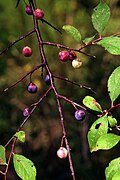| Prunus umbellata | |
|---|---|
 | |
| Prunus umbellata bush | |
| Scientific classification | |
| Kingdom: | Plantae |
| Clade: | Tracheophytes |
| Clade: | Angiosperms |
| Clade: | Eudicots |
| Clade: | Rosids |
| Order: | Rosales |
| Family: | Rosaceae |
| Genus: | Prunus |
| Subgenus: | Prunus subg. Prunus |
| Section: | Prunus sect. Prunocerasus |
| Species: | P. umbellata |
| Binomial name | |
| Prunus umbellata | |
| Synonyms [2] | |
List
| |
Prunus umbellata, called flatwoods plum, hog plum and sloe plum, is a plum species native to the United States from Virginia, south to Florida, and west to Texas. [3] [4]
Contents
Prunus umbellata can reach 6.1 meters (20 feet) in height with a 4.6 m (15 ft) spread. It has alternate serrate green leaves that turn yellow in autumn. Flowers are white, creamy, or grayish. Fruits are round, purple, and 1.3–2.5 centimeters (1⁄2–1 inch) in diameter. [4] The trees bloom and bear fruit later than other plums. The fruits mature August–October. Large crops appear only every 3–4 years. [5]
P. umbellata trees can live up to 40 years and are very difficult to distinguish from P. angustifolia , with which it hybridizes easily. [6]
The fruits are made into jellies and jams. [7]


